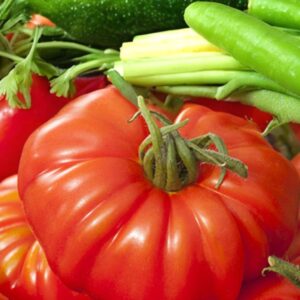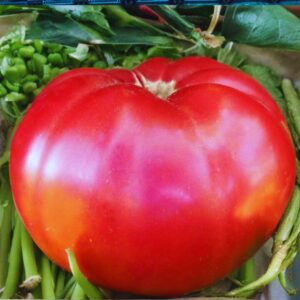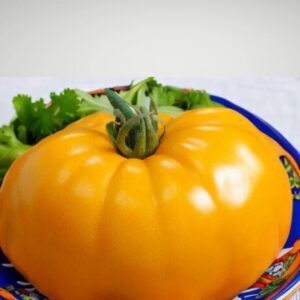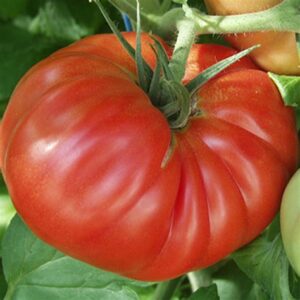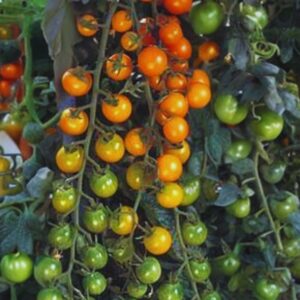ORGANIC HILLBILLY HEIRLOOM TOMATO
2,500 د.ك
This multicolored heirloom tomato originates in the mountains of West Virginia. Ohio gardener Jerry Lee Bosner introduced this seed to Seed Savers Exchange for commercial use in 1994.
Sowing: Start tomatoes indoors 6-8 weeks before the last frost of spring, sowing the seeds in a flat 1/4″ deep and 1″ apart. Keep the temperature at 70-75 degrees F until germination, as well as providing adequate light in a sunny window or under a grow light; keep the soil moist, but make sure drainage is adequate. When the second set of leaves emerges, transplant the seedlings into individual pots; bury the stems up to the lowest set of leaves to grow strongly rooted plants. A week before planting the seedlings outside, begin exposing them to the weather during the day to harden them; tomatoes cannot endure cold weather, and should not be transplanted outside until all threat of frost has passed. When the soil temperature reaches at least 70 degrees F, plant the seedlings in full sun and very rich soil; once more, bury the entire stem up to the lowest set of leaves. If providing a trellis, space the plants 2′ apart, but if allowing the vines to spread, space the plants 3-4′ apart. For companion planting benefits, plant tomatoes with carrots or onions, but avoid planting them with cabbage or tomatoes.
Growing: Indeterminate tomato varieties often perform best when provided with a trellis or support, since this protects them from various pests and diseases in connection with too much soil contact. Put the supports in place before the seedlings develop vines. As the vines begin to grow, tying them to the support helps their development. Since temperatures below 55 degrees F can damage production, protect the plants if temperatures drop. A thick layer of mulch helps conserve moisture and control weeds; water the plants once a week, but avoid getting the leaves wet. Pruning the “suckers,” or shoots that grow between the main stem and the branches, will greatly improve the production and strength of the plant.
Harvesting: Test the ripeness of tomatoes by pressing them gently; the flesh should yield slightly. The mature color also indicates ripeness. If the stem does not come easily off the vine, cut it with a scissors. Vine ripened tomatoes have the best flavor, but as soon as frost comes, all tomatoes should be harvested, even the green ones. Unripe tomatoes will ripen eventually if kept in a warm place out of direct sunlight.
Seed Saving: Since cross pollination between most tomato varieties is unlikely, isolation is not a concern. Pick fully ripe tomatoes and cut them in half horizontally, across the middle; squeeze out the pulp into a container. An alternative method for smaller tomatoes is to put them in a blender and pulse the mixture, since the seeds are hard and slippery and will not be harmed. Let the mixture ferment for several days or until a thick layer of mold has formed; this process removes the gelatinous layer on the seeds. Pour off the mold and debris, saving the good seeds on the bottom. Rinse the seeds in a strainer under running water until they are clean, then spread them out to dry in a protected location away from direct sunlight. Stir them twice a day, and provide a fan to speed drying if the air is humid. Once the seeds are completely dry, store them in a cool, dry location for up to four years.
Latin Name: Lycopersicon esculentum
Type: Open Pollinated, Heirloom, Indeterminate, Warm Season
USDA Zones: 3, 4, 5, 6, 7, 8, 9, 10, 11, 12
Seeds per Ounce: 10,000
Planting Method: From Transplant
Sunlight: Full Sun
Height: 96 Inches
Color: Red
متوفر في المخزون





